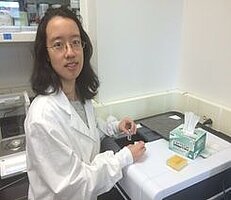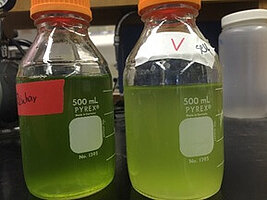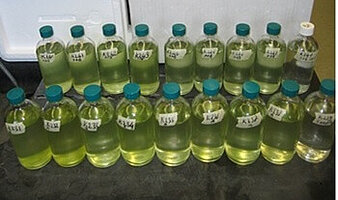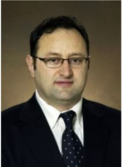Evaluation of Bioavailable Dissolved Organic Nitrogen Using Various Algal Species

Jingyi Sun obtained her B.S degree in Water and Wastewater Engineering from Beijing University of Civil Engineering and Architecture, Beijing, China in June 2013. During her B.S. education, she was an exchange student in Civil Engineering Department at NDSU from August 2012 to May 2013. From August 2013, she became an M.S. student in Department of Agricultural & Biosystems Engineering at NDSU. Her research focus is to evaluate bioavailability of dissolved organic nitrogen using various types of algae for samples obtained from wastewater treatment plants(WWTPs) and animal feedlots.
Fellow: Jingyi Sun
Advisor: Advisor: Halis Simsek, Ph.D., Assistant Professor, Department of Agricultural and Biosystems Engineering, North Dakota State University
Degree Progress: M.S in Agricultural & Biosystems Engineering in Fall 2015.
Evaluation of Bioavailable Dissolved Organic Nitrogen Using Various Algal Species
Wastewater derived dissolved organic nitrogen (DON) from wastewater treatment plants and from animal feedlots are important nutrient sources for bacterial and algal communities in surface waters such as rivers, lakes, and estuaries. Excess amount of DON in surface waters can stimulate overabundance of algal growth, cause dissolved oxygen depletion and ultimately cause eutrophication in water ecosystem. Bioavailable DON (ABDON) is a fraction of DON that is directly or indirectly available as a nitrogen source for algal species through hydrolysis process. Knowledge of bioavailability of DON is critical for a better understanding of the fate of DON in surface wasters. The outcomes from this study will help to decrease nitrogen discharging to receiving waters from wastewater treatment plants (WWTPs) and from animal feedlots. In addition, algal usage in WWTPs might provide a basis for protecting aquatic ecosystems from cultural eutrophication. In this study, bioavailability of DON were investigated during 14 and/or 21 days of incubation periods using three different algal strains, which were Selenastrum capricornutum, Chlamydomonas reinhardtii, and Chlorella vulgaris and mixed culture bacteria.
Project Objectives:
The objective of this study is to collect DON and ABDON data from wastewaters originated from WWTP and animal feedlots. Three different algal species, S. capricornutum, C. reinhardtii and C. vulgaris and their combination with bacteria were used to determine DON and ABDON data in the samples collected from three different locations along the two-stage trickling filter (TF) WWTP and two different locations in an animal feedlot. The results were analyzed and compared to investigate if C. reinhardtii and C. vulgaris were also suitable same as the test species S. capricornutum to use as control species in aquatic environment.
Progress:
Six sets of experiment were conducted to determine dissolved nitrite, nitrate, and ammonia, total dissolved nitrogen, DON, and ABDON in wastewater samples collected from three different locations, which were after primary clarifier, after BOD trickling filter, and after nitrification trickling filter in Fargo WWTP. Currently, all the experiments were completed and data organization and manuscript preparation have been continuing. Some part of the studies were presented in local or nationwide conferences while the other parts were accepted in upcoming conferences. The overall results will be submitted for publication in a peer reviewed journal(s). A final report containing all the information on the project will be delivered at the end of the project.
Significance:
This research provides important outcomes to improve the quality of receiving waters (Red River in North Dakota) by minimizing the nutrient entrance to surface waters either from WWTPs or from animal feedlots. Using algae to treat the wastewaters is a natural and cost effective way and provides a basis for protecting aquatic ecosystems from cultural eutrophication. For the first time, different algal species were used to examine the bioavailability of dissolved organic nitrogen in two-stage trickling filter WWTP and an animal feedlot. Determining the best treatment conditions for pure-cultured and/or mixed cultured algae helps to understand nutrient removal potential of algae with/without bacteria. In addition, investigating the removal efficiency of ABDON by comparing with different species and different sampling locations provide data to find a method to reduce nitrogen discharges from point sources to the receiving waters. Furthermore; the results from this study might be used to design a small scale on-site wastewater treatment plant to treat wastewaters from feedlots and agricultural areas.
Conference/Seminar Presentations:
Sun, J., Ohm, J., Blonigen, M., Simsek, H., 2015. Evaluation of Bioavailable Dissolved Organic Nitrogen in Municipal Wastewater Using Algae Chlamydomonas Reinhardtii and Chlorella Vulgaris. 86th Annual Water Environment Federation Technical Exposition and Conference (WEFTEC), September 26-30, 2015, Chicago, Illinois.
Sun, J., Khan, E., Ohm, J., Simsek, H., 2015. Biodegradable and bioavailable dissolved organic nitrogen in animal wastewater. American Society of Agricultural and Biological Engineers (ASABE) International Meeting, July 26-29, New Orleans, Louisiana.
Sun, J., Simsek, H., 2015. Nitrogen removal in treated municipal wastewater effluent using three different pure cultured microalgae (C. reinhartti, C. vulgaris, and S. capricornutum) and mix cultured bacteria. Presented at North Central American Society of Agricultural and Biological Engineers Conference, April 10-11 2015, Fargo, North Dakota.
Sun, J., Kasi, M., Khan, E., Simsek, H., 2014. Nitrogen removal in municipal wastewater using pure cultured algae. Poster presented at the 86th Annual North Dakota Water and Pollution Control Conference (NDWPCC), October 14-16, Fargo, North Dakota.
Sun, J., Kasi, M., Khan, E., Simsek, H., 2014. Bioavailability of organic nitrogen in wastewater to two different pure culture algal species. Presented at American Society of Agricultural and Biological Engineers (ASABE) intersectional Meeting. March 28-29, Brookings, South Dakota.



Halis Simsek
AES Ag & Biosystems Eng
Office: ABEN 2016
Phone: 701-231-6107
Email: halis.simsek@ndsu.edu


